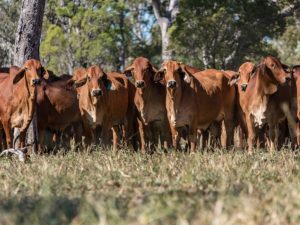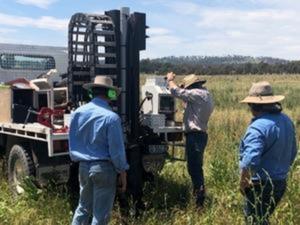
Dennis Donohoe, farm manager with Aminya Pastoral, is a seasoned producer with decades of experience, and his story is a testament to how even minor changes in farming practices can lead to significant improvements in productivity and land health.
The first lot of evidence is in!! Cattle in a cell-grazing system, following the RCS grazing principles, are sequestering between 100 and 300 kg of CO2e for every kg of live weight produced. Therefore in round figures every kg of steak or mince consumed from a regeneratively grazed property, will remove between 50 and 150 Kg of CO2e from the atmosphere!! This is after accounting for both general emissions (fuel & fertilizer) and methane at a ridiculously high factor per LSU.
This means the narrative about cattle harming the environment via methane emissions is not only wrong, but this real-world data, collected from over 10,000ha over five years, which included the 2018-19 drought, shows how dangerous the broadly held narrative really is.
 The data from cell grazed properties confirms that the more beef that is eaten from this system, the more CO2e is removed from the atmosphere, by up to 150:1. Is this likely to counter the trend of “meat-free Mondays” and banning the advertising of beef? Probably not, because the beef industry lost control of the narrative a long time ago. However, we need to develop more of this data, change the grazing practices in the industry and tell the story better.
The data from cell grazed properties confirms that the more beef that is eaten from this system, the more CO2e is removed from the atmosphere, by up to 150:1. Is this likely to counter the trend of “meat-free Mondays” and banning the advertising of beef? Probably not, because the beef industry lost control of the narrative a long time ago. However, we need to develop more of this data, change the grazing practices in the industry and tell the story better.
The Roots Regenerative beef brand is a great start in this direction, indicating markets are already seeking the regen label. I was also invited to a meeting in Dublin in October 2022 to see how the narrative can be changed, not just from an environmental perspective but also from a health and cultural perspective.
Over the last few months there has been a lot of fear mongering advising farmers not to sell carbon credits earned on farm, because one day you will need them to be carbon neutral. Lets break this down with some facts.
Carbon Neutral means that any CO2 released into the atmosphere from a company’s activities is balanced by an equivalent amount being removed. E.g. if I have emissions of 2,000t CO2e, I would need to reduce emissions or offset them by 2,000t CO2e.
Carbon neutral means that all your emissions are either eliminated or offset (meaning someone has sequestered carbon and used it to offset emissions).

The term Net Zero means achieving a balance between the carbon emitted into the atmosphere, and the carbon removed from it. This balance – or net zero – will happen when the amount of carbon we add to the atmosphere is no more than the amount removed. Net zero means that you still have emissions above a baseline level. Australia has a target to be net zero by 2050. What that means is that emissions will have to be driven down beyond 2005 levels (559.1 million tonnes of carbon dioxide equivalent (CO2e). The current target is 43% below that by 2030. We were at 488 Million tonnes for the year to Dec 2021.
Carbon Negative (sometimes called Climate Positive – just to add confusion!!) means that all emissions have been offset (Carbon Neutral) and there is still carbon being sequestered. This is possible in agriculture.
Lets assume the following in order to make sense of this.

In the above scenario 19,000t is what can be sold and the product is at net zero. If you wanted to become carbon neutral you would retire the 2,000t baseline, reducing the carbon sale to 17,000t per annum. In reality however, properties sequestering 20,000 t of CO2e per annum, currently have baseline emission levels of around 1,000 t CO2e.
Is the argument about not selling credits real or scare mongering? Look at the real world data and you be the judge.
That is probably enough for round 2.
Terry
Author:

RCS Co-Founder
Related:
Have a listen to The Weekly Grill Podcast where Kerry Lonergan chats to Terry about understanding the increasing complex carbon market.
Profitable Paddocks is our educational newsletter sent to your email inbox every quarter.
Click the Bell for the latest blogs.

Dennis Donohoe, farm manager with Aminya Pastoral, is a seasoned producer with decades of experience, and his story is a testament to how even minor changes in farming practices can lead to significant improvements in productivity and land health.
Once you have ownership as to why planning is important, the next ingredient is to work out where and how you will do your planning. When you write something down you change your relationship with the content. I cannot emphasise enough the power of getting your thoughts and plans out of your head onto paper or the computer.
The season in SA and Tassie is particularly tight right now with little or no useful rain since early January and a generally failed 2023 spring prior to that. Right now, across southern Australia and much of the eastern NSW, you won’t need to drive far out into the countryside to see cattle and sheep grazing (and lying on) hay and silage trails lined across paddocks.
Martha Lindstad and partner Robert James are farm managers on ‘Karalee’, Enngonia NSW. Both have travelled different paths to being where they are. Martha is originally from Norway, growing up on a three hectare farm before travelling to New Zealand and eventually the Pilbara in Western Australia. It was here that she saw the benefits of sustainable farming for the country and livestock.
The Prince’s RCS mentor, Raymond Stacey, sees a strong future ahead for Simon and Laura. “The Drought Resilient Soils and Landscapes project is about supporting graziers to manage their country and businesses better,” Raymond said. “I see an operation here where they’re working hard on their planning and putting their plans into action to leave their country, business and people in better shape.”

Join our mailing list
